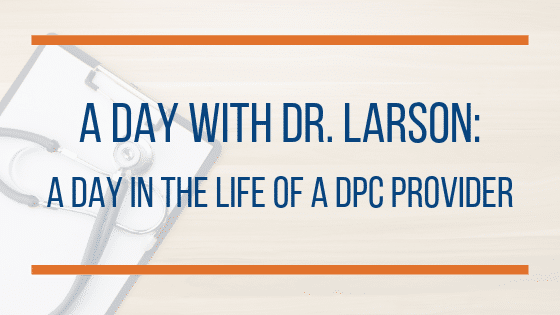Note: All patient names have been changed to protect their privacy.
What does a typical day in the life of a Direct Primary Care (“DPC”) physician look like? For Dr. Chris Larson at Euphora Health in Austin, TX, the days are full and varied, including plenty of interaction with patients. Here’s a typical Monday for Dr. Larson.
9:00 am – Care Coordination to Cost-Effective Surgery
My work week began over the weekend this particular Monday because a patient had ended up in the ER. This patient enjoys DPC benefits through her employer, and her husband contacted me on Saturday, informing me that his wife, “Dawn,” had been in an accident.
Dawn is a 43-year-old female and had suffered a fracture of multiple parts of the tibia and fibula on the right side when a golf cart rolled over her leg, and she was taken directly to the emergency room. I asked the patient’s husband to send me copies of the X-rays taken at the ER and began to assist with finding an orthopedic surgeon to perform surgery on Dawn’s fracture.
I used Texas Free Market Surgery to help the family find a fairly-priced surgery, and on Monday morning checked in on the process to see that the pre-operation visit had been scheduled.
It was another case of DPC saving a patient and her employer thousands of dollars—the total price of the surgery was $11,150, and the employer-based DPC plan paid the entirety of the bill. The patient could go home without any mysterious and unmanageable hospital bills following her, and the employer was happy to pay for quality care at a much more affordable price. According to the Healthcare Bluebook website, a lower leg fracture surgery in the Austin area is likely to cost between $11,286 and $36,000—or more. As you can imagine, employers are often pleased to provide full coverage for needed healthcare when they can save thousands of dollars and have price transparency through DPC.
10:00 am – Counseling a Patient with Chronic Back Pain
My first in-office visit in of the day is “Sheila,” a 43-year-old female who stays at home and suffers from chronic back pain and doesn’t have insurance. Sheila’s back pain has been flaring up at an increasing rate over the past several years and has worsened significantly in recent months.
In addition, I recently diagnosed her with a skin condition called porokeratosis. I had performed a skin biopsy (a free in-office procedure for Sheila) and sent the specimen to a pathologist that gave us a pre-contracted rate of $50 to confirm the diagnosis.

During Sheila’s appointment at the Austin clinic today, we spend about 20 minutes discussing ways Sheila can manage and reduce her back pain. She has been going to physical therapy at my recommendation but experiencing frustrating setbacks in her journey toward living a life with less pain. I give her feedback, mainly in the area of ergonomics, and troubleshoot with her.
This kind of conversation is one that I believe is uncommon outside of DPC. I could freely spend more time with Sheila getting into a very granular discussion, making her feel heard and giving her feedback, because of the nature of the Direct Primary Care doctor’s schedule. Sheila is hoping to avoid relying on pharmaceuticals to deal with her back pain, and I’m free to spend time guiding her to other options.
During the office visit, we also discuss Sheila’s new skin lesions related to her porokeratosis. I take a picture and submit it, along with her labs, biopsy results, descriptions, and medical history, to RubiconMD for a dermatologist to give me a secure consult at no extra cost to Sheila. Later in the day, I’ll receive a list of recommendations from the dermatologist for next steps for Sheila’s skin condition.
10:45 am – Telemedicine with “John”
At 10:45, I have a phone call with “John.” John is a 38-year-old male who has DPC through his employer. He works for a large employer in the Houston area, and I provide services to him and his coworkers via video teleconferencing, phone calls, texts, and emails. Twice a year, I visit his workplace and sit face-to-face with patients at the worksite.
John had texted me concerning a lymph node that had been increasing in size over the past couple of weeks. I ask him a few questions, confirm some details of his health history, and recommend he have lab work taken near his home. With my help, John will have lab work done for a maximum of $35, even though the total cost of labs is generally about 10x higher at insurance-based clinics.
11:00 am – Telemedicine with “Jason”
At 11:00 am, I receive a text message from a 39-year-old male patient, “Jason,” who is the owner of a small construction company. Jason had shot a nail into his finger 10 days prior while on a job site and knew the nail had hit bone. He was continuing to experience pain and texted for my recommendation.
I moved the discussion from a text message to a phone call, and through a series of questions and a conversation, confirm that Jason’s finger is not getting worse. I give Jason instructions to continue his current care plan and to watch out for signs of infection and to contact me if he sees those signs.
11:30 am – A quick in-office Wart Treatment and Text Consultations
Between 11:30 and noon, I help three patients. One 41-year-old male who has DPC coverage through his employer came into the office for quick wart removal. In a prior visit, we had discussed options for removing his wart, and he had chosen a liquid-based treatment. Within 5-10 minutes, I administer the treatment and put an occlusive tape on it. The patient is out the door at no cost to him, and his wart is handled with no pain and no hassle.
After this visit, I text back and forth with a patient who is dealing with a yeast infection. She and her husband are both patients and are trading a yeast infection back and forth. The patient asks questions about how to control the yeast infection and how long to abstain from intercourse.
12:00 pm – Helping “Frank” Avoid Diabetes
At 12:00 pm, I have an in-office visit with a 58-year-old male patient, “Frank.” Frank lives in Houston and doesn’t have insurance, but is a member of a health sharing ministry. Frank was in Austin for business and scheduled his appointment while he was in town.
Frank has recently been diagnosed with pre-diabetes based on some lab work I ordered for him in his hometown of Houston. Over the past two months, Frank has been working hard on the lifestyle changes I’ve recommended and coached him through and has lost around 20 pounds.
During the visit, I take his blood pressure and calculate his cardiovascular risk. Through conversation, I’m able to show Frank how his risk calculation would go down with a decrease in his cholesterol numbers. Frank wants to try to avoid medication and collaboratively, we settle on a plan to continue pursuing lifestyle changes and follow up again in a month.
12:45 pm – Sending in a Needed Prescription
A mother, who has DPC through her employer-provided healthcare plan, texts me concerning her 10-month-old. The mother lives in Lubbock and has concerns about her 10-month-old’s continued illness. She had brought her child into an ear, nose, and throat specialist two days ago, and they had recommended an antibiotic and anti-inflammatory ear drop prescription as a precautionary measure in case her child’s illness didn’t improve. By some mix-up, the ENT’s office had failed to send in the prescription and wasn’t answering their phone. I sent in the prescription for the patient for quick treatment initiation.
1:00 pm – Helping with “Heather’s” Cold
Heather, a 29-year-old female, is dealing with a cold. She’s had a cough for about five days and needs help getting adequate sleep at night. Through a thorough phone call, I’m able to rule out anything beyond a cold and send in a prescription to help her.
1:30 pm – Helping “Hannah” Save Money on Imaging
At 1:30 in the afternoon, I have an in-office visit with “Hannah,” a 41-year-old female and the owner of a local theater company. Hannah is training for a marathon but suffering right hip pain that is keeping her from running. She has gone to physical therapy, but things don’t seem to be improving. I examine her hip, and after the exam, I’m still not certain what the underlying issue is. I order an MRI for Hannah using RadiologyAssist.
Using RadiologyAssist, I’m able to give Hannah access to a joint MRI with an injection for $650, a price drastically lower than the typical $2,000-$2,500 price tag with insurance-based care. I set everything up for her and walk her through the process.
2:30 pm – “Jean” Gets a Prescription While at Work
I have been conversing with “Jean,” a 34-year-old female, through our client care portal, and convert that conversation to a phone call. Jean has symptoms consistent with a urinary tract infection, and over the phone, I am able to rule out other possible issues or concerns. With Jean’s health history and a detailed phone conversation, I’m able to diagnose Jean’s UTI and get her a prescription—and she never even has to leave work.
3:00 pm – “Ashley’s” New Patient Visit
“Ashley” is a new patient, and I’m able to spend a significant amount of time with her. I prefer to schedule new patient visits with plenty of time to discuss anything on the patient’s mind and establish a health history. During this initial visit, we conduct lab work, which costs Ashley around $25.

Ashley is 31-years-old and has suffered from anxiety and insomnia since she was a child. Ashley and I have a long conversation about how to best manage her anxiety and insomnia. I recommend lifestyle changes, as well as low-cost counseling and discuss the benefits of cognitive-behavioral therapy for insomnia with her. I also write her a prescription for an anxiety medication she has taken in the past and found helpful and schedule a follow-up call in the next 10-14 days.
4:00-5:00 pm – Clean up, Communication, and Heading Home
During my final hour in the Austin office, I spend some time cleaning up and communicating with patients. I schedule patient phone calls, schedule a patient’s thyroid ultrasound, and respond to another patient’s questions about her husband’s swollen legs.
I send in refill requests, biopsy results, and lab results for various patients. At about 5:10, I’m in my car heading home to my family. At the end of this busy Monday, as with any day, I leave my office knowing I’ve done my best to take care of my patients today.

